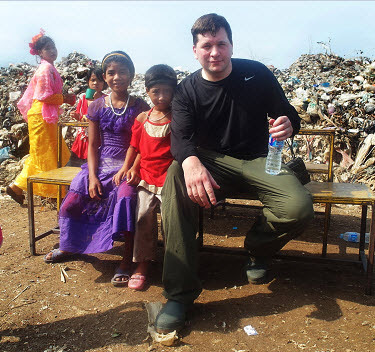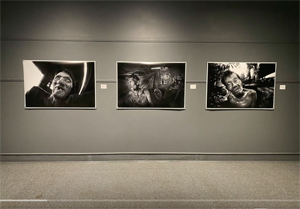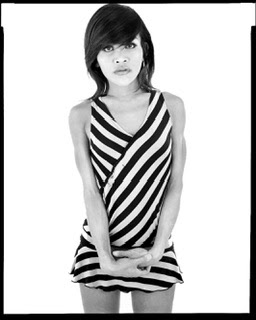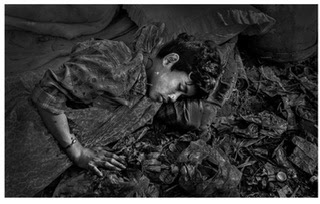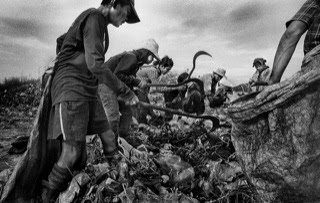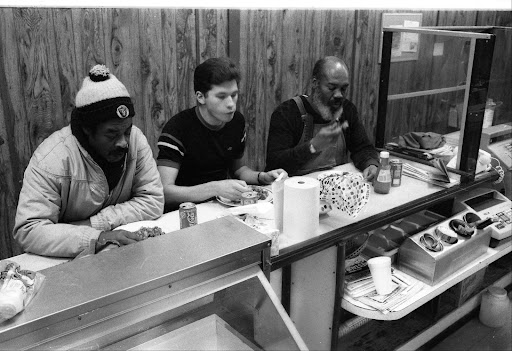
By Frank Van Riper
Special to Camera Works
It was in the 1970s, Dennis Brack recalled, as he made ready to photograph Ronald Reagan after the Florida Republican primary. Brack, one of the best in the business, was shooting for Time Magazine and knew Reagan well. Conversation with the ex-governor, film star and then-presidential candidate came easily.
That was quite a famous photographer who was here the other day, Brack declared. [Coincidentally, Brack's photo shoot came shortly after Reagan, the ex-movie star who never met a camera or a photographer he didn't like, had posed for Richard Avedon.]
"He wasn't very good," Reagan told Brack. The actor/politician then described Avedon's bulky view camera equipment and his unique-some might call it excruciating– portrait style.
"He was very slow," Ronald Reagan said.
Richard Avedon will turn 80 next year and for much of his life he has been fired by anxiety and the compulsion to make images. When he was a child growing up in New York in a prosperous Jewish household [his father and his uncle owned Avedon's of Fifth Avenue, a chic women's specialty shop] he sometimes would tape paper profiles to his skin so that the faces would remain on his sunburned body.
He remembers having an eye twitch that annoyed his family, but recalls too that the constant blinking was a way for him to make still pictures in his mind.
"It comes in the genes," Richard Avedon once said.
The tendency is to think of Avedon as one thinks of Picasso: an artist who has gone through many periods, each in its own way significant and successful. His fashion work, for Harper's Bazaar, Mademoiselle and Vogue, gave the staid fashion world of the 50s a deserved kick in the pants. Who else would photograph a gorgeous, willowy, dressed-to-the-nines model in between two elephants? (Well, Steichen actually, but he used a horse.)
His editorial photography, appearing not only in these magazines, but decades later in magazines from Rolling Stone to the New Yorker, always had a characteristic style that made you know the work was his.
His advertising work, often in color, was lush yet also edgy, and done with the help of an invisible army of stylists and assistants.
But, even with the inevitable overlap among these genres, it likely will be Avedon's more personal work that shapes his huge legacy when finally he is gone.
Richard Avedon: Portraits, on display at New York's Metropolitan Museum of Art through January 5th, distills this great photographer's work in a way that surely he desired. The elaborate fashion sets are gone; banished too are the environmental portraits showing a subject in his or her milieu. This distillation of more than a half century of work is itself a distillation-of style.
"I've worked out a series of No's," Avedon tells visitors to his show in a text block on the wall. "No to exquisite light, No to apparent composition, No to the seduction of poses or narrative. And all these No's force me to the Yes. I have a white background. I have the person I'm interested in and the thing that happens between us." Thus there now are on the gallery wall only the subjects and the seamless backdrop, most often dead white, but occasionally a shade of grey. Full-length, three-quarter, close-up–most often singly, but at times in groups. Nothing but the person-no context to shape our opinion, no background to guide our thought. Just the person and what that person brought to the portrait session, whether he or she knew it or not.
To some this will call to mind "In the American West," Avedon's riveting documentation of everyday people from an area that surely was as alien to a native New Yorker as Manhattan would be to a cowboy. Just as surely one could think of his searing portraits of those we've come to know through notoriety, fame or a combination thereof– pictures that always offer a take we've never seen before, but once seen this way, cannot be ignored or forgotten:
A withering view of the Duke and Duchess of Windsor-a profile of well-dressed languor and weakness; a lost Marilyn Monroe, her perfect breasts haltered in sequins, her gaze vacant, her pouty lips parted; A pensive, even somber Groucho Marx after all the jokes have been told, seemingly confronting his own mortality.
Even Ronald Reagan, as always standing at attention in a dark blue suit, but with a questioning gaze that seems to ask: "are you sure this is what you want?"
Over the years Avedon has weathered criticism for these supposedly cruel or confrontational portraits. Criticism too for allegedly standing sphinx-like behind his formidable view camera until his subject weakens and takes an action or adopts a pose or expression that may be visually interesting but surely out of character. And, certainly, the pictures on the walls of the Met are strong, and often disturbing.
But cruel? No, they are not cruel. What they are is powerful in a way that confronting one's own humanity as well as the humanity of others we know or admire can be devastating.
It needs to be remembered, and repeated, that in photography, especially in portrait photography, the final image is always-always–collaboration. Only one who draws or paints has total control over the final rendering. That is the real power to be cruel.
In a 1985 taped interview with Connie Goldman to coincide with "In the American West," Avedon described perfectly, I think, how this collaboration works:
"A portrait photographer depends on another person to complete his picture...he is willing to become implicated in a fiction he can't possibly know about..."
"My concerns are not [my subject's]," Avedon went on. "We have separate ambitions for the image.
"His [the subject's] need to plead his case probably goes as deep as my need to plead mine. But the control is with me."
That control, as well as his talented eye, has enabled Richard Avedon to capture expressions and gesture that seem uncannily right, even if in so doing he might seem heartless. "I've looked for the humanity in all of the people I've photographed," Avedon has said-and it is hard not to believe him.
The process itself is fascinating, as well as instructive-though one gets to that in small pieces and in snippets from assistants. Like many artists guarding their magic, Avedon has little desire to tell-all about how he actually does it.
But this we do know....
For "In the American West" Avedon worked with an 8x10 view camera. His subjects stood outdoors against a white backdrop. Avedon rarely engaged his subjects in conversation once they were selected-from newspaper advertisements, or from Avedon's own personal observation.
But once before the camera, as one of his subjects recalled, "You never really noticed the camera-you felt his presence even behind the lens." An assistant recalled that from behind the camera, Avedon's body often would "take on the appearance of the person he [was] photographing."
"I'm best in short takes that are intense," Avedon told interviewer Goldman, adding that when he is photographing someone, the subject has to feel as if he or she "is the most important person in the world at this moment...they've got to feel that."
This is not the m.o. of someone aiming to be cruel–or ironic or superior. This is the modus operandi of one of the greatest portraitists of our time.
The Metropolitan show, drawn from actual exhibition prints from previous shows, is dominated by Avedon's now-signature monumental prints. Interestingly, two walls are devoted to much smaller images, of politicians and other public figures, made around the 70s. These are some of the weakest pieces here, but not because they are small. My sense is that pols and public figures are less likely than others to let any but their cultivated persona be caught on film.
Shortly after the Avedon show opened, photographer Neil Selkirk, who knows Avedon, wrote to his colleague and said this about the western portraits, though his thoughts could apply to almost everything on the walls:
"Individually they are exquisite and absorbing, as a group they are a collection of monoliths; as the Pyramids or Stonehenge are to architecture, nothing that follows (or precedes them) in photographic portraiture can be considered without reference to them. Can there be a more enduring achievement?"
I certainly can think of none.
Richard Avedon: Portraits. Through January 5. Metropolitan Museum of Art, Fifth Avenue at 82nd St, New York City (212-879-5500) Tu-Su, 9:30-5:30; Fri and Sa evenings until 9.
Frank Van Riper is a Washington-based commercial and documentary photographer and author. His latest book is Talking Photography (Allworth Press), a collection of his Washington Post columns and other photography writing over the past decade. He can be reached through his website www.GVRphoto.com.



















































